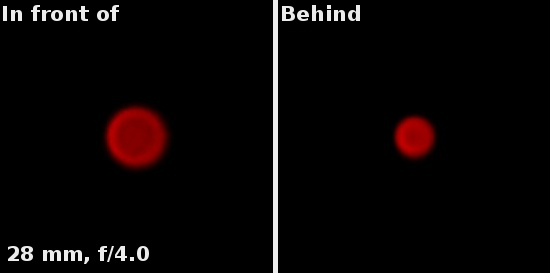Tokina AT-X PRO DX 12-28 mm f/4
5. Chromatic and spherical aberration
Chromatic aberration
The longitudinal chromatic aberration is a bit of a problem at the longest focal length. The crops below show distinct colouring of defocused images both by f/4.0 and f/5.6. The effect is perhaps not very strong but certainly noticeable.
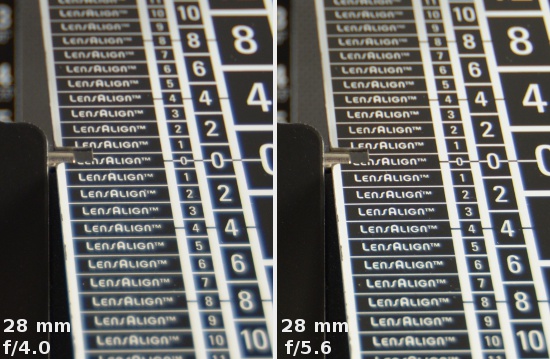 |
Please Support UsIf you enjoy our reviews and articles, and you want us to continue our work please, support our website by donating through PayPal. The funds are going to be used for paying our editorial team, renting servers, and equipping our testing studio; only that way we will be able to continue providing you interesting content for free. |
- - - - - - - - - - - - - - - - - - - - - - - - - - - - - - - - - - - - - - - - - - - - - - - -
Already while testing the Tokina 11-18 mm f/2.8 II and the predecessor of the tested lens we had a lot of serious reasons to complain about the lateral chromatic aberration. You don’t observe often results on a level of 0.24 –0.28% and, to tell you the truth, we wish such records were even rarer, preferably non-existent. Unfortunately the Tokina 12-28 mm shows that in this category you can get worse than that.
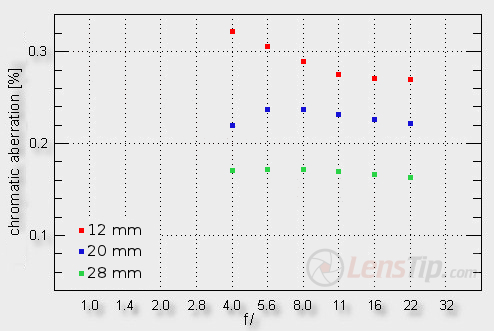
At the most demanding combination of the maximum relative aperture and 12 mm focal length the aberration amounts to a truly monstrous level of 0.32%. It’s true –on stopping down it decreases but quite slowly and even after a significant decrease of the aperture size the aberration remains huge, reaching 0.27%.
The situation improves with the increase of the focal length but, to tell you the truth, it never becomes really good. At 20 mm the lateral chromatic aberration depends only weakly on the aperture value and keeps a very high level of about 0.22-0.24 %. At 28 mm the aberration is the lowest, amounting to circa 0.16-0.18%.
Looking at the crop below you see how serious the problem really is. The crop presents a measurement area used to asses the resolution in the centre (!) of the frame, in the distance of just more than a dozen percent of the image circle radius. In most of lenses such area is completely free of lateral chromatic aberration because it is situated too close to the centre but the Tokina is an exception. Its monstrous aberration makes even the edges noticeably coloured.
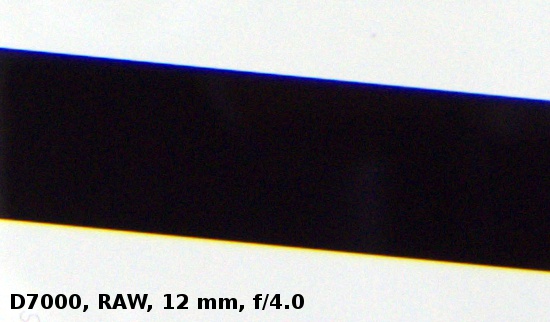 |
It is not difficult to guess that crops taken from the edge of the frame are going to look much worse. The examples are presented below.
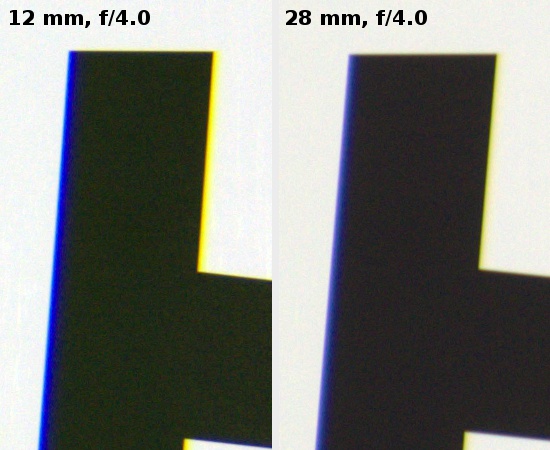 |
The situation is so dramatically bad that it makes us wonder what happened and why. Cannot Tokina constructors correct the chromatic aberration? Or perhaps they don’t want to do so? The first possibility would reflect very badly on them, especially that they have low dispersion glass at their disposal and they often boast of that fact. The second variant is hardly better. Of course you can follow a way similar to that of the Micro 4/3 system optics constructors – they gave up on distortion correction and that one additional degree of freedom was used to improve the correction of other aberrations. The Tokina producers sacrificed the lateral chromatic aberration – but perhaps their choice wasn’t exactly great. That aberration, like the distortion, can be corrected by software. Still, while the software correction of the distortion limits mainly the field of view, the software correction of the chromatic aberration gets rid of colours without retrieving the lost resolution. Tokina constructors, do not follow that path, please!
Spherical aberration
The first picture in this chapter shows that we don’t have to expect any serious spherical aberration problems. The tested lens didn’t have any ‘focus shift’ tendency which means that the spherical aberration, if occurs at all, is low.
However, the defocused light points prove that it is not corrected perfectly well. The circles are noticeably lighter on the edges and darker in the middle. Fortunately they look the same in front of and behind the focus so this kind of aberration is not very bothersome.
